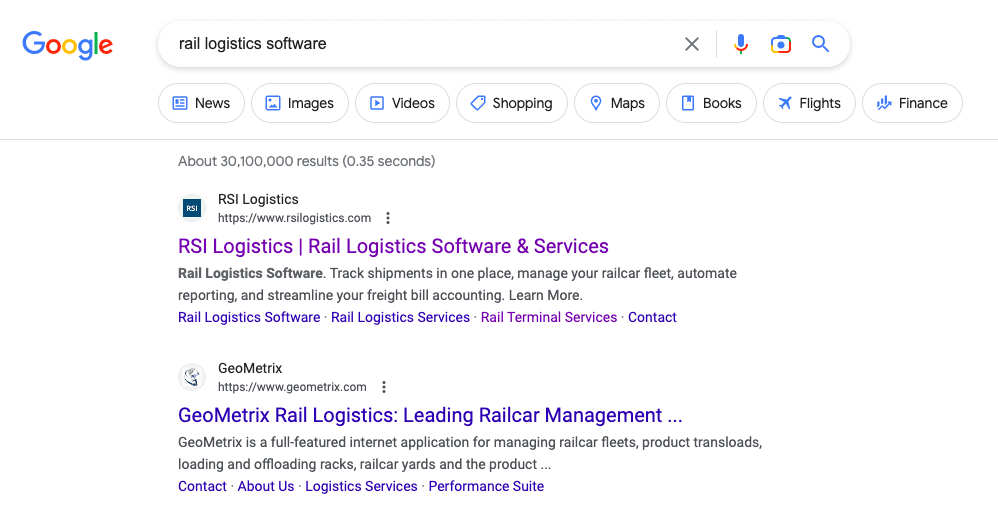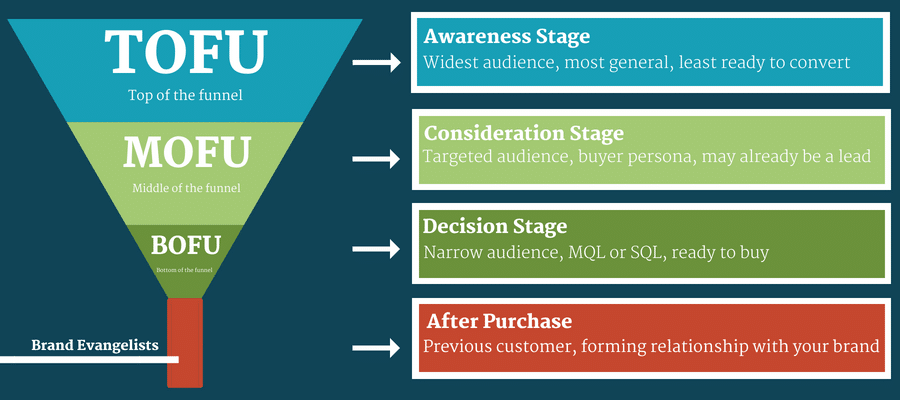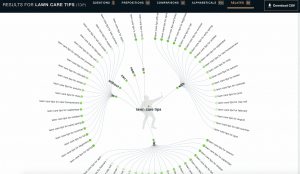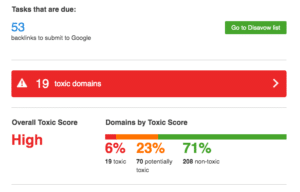
For your website to be useful and valuable, your audience needs to be able to find it. That’s where search engine optimization (SEO) comes in. An SEO strategy can help you create the right content on your site, so your audience can find it. An SEO strategy that actually delivers ROI will not only improve your traffic, but it will also increase leads and provide value greater than what you invest.
What is SEO?
Search engine optimization or SEO is the process of making your website easier for search engines (like Google or Bing) to find and rank highly. With the right optimization, users will be more likely to see your website or web page listed at the top of a list of results when they enter a relevant search.
For example, our client, RSI Logistics, builds software to help businesses ship their goods via rail more efficiently and affordably. It’s important that they appear at the top of a list of results when a user enters a search like “rail logistics software,” which they do. As a user explores different options and solutions to their rail shipping challenges, they’ll see RSI Logistics first. This helps RSI Logistics connect with more potential customers and build more leads.

It’s important for our client, RSI Logistics, to appear at the top of the search results when a user enters a relevant phrase like this one. A strategic SEO plan helps to make that possible.
How To Improve SEO
Before we focus on how to make an SEO strategy that delivers ROI, let’s take a look at a few things that improve SEO overall. There are many different factors that affect how Google and other search engines rank your page. In general, Google is designed to show its users pages (or videos or images) that are:
- Relevant and helpful: the results should actually answer the user’s question or provide additional information about the user’s search terms.
- Accessible: the user can view and understand the content without problems like slow load-times or lots of technical jargon.
- Accurate: the information on the page is correct, reliable, and uses additional sources to back up the information.
Of course, these ideals are generally built into the algorithm, but they’re far from perfect. A user’s location and search history, among other factors, can influence how results appear. Some businesses also have more resources to put behind their SEO strategy, which can “game the system” in some lucrative industries, and sometimes put lower-quality results above higher-quality results.
With the previous points in mind, let’s go over a few important aspects of SEO, including on-page SEO and off-page SEO.
On-Page SEO
On-page SEO factors refers to the things on your page that you can control. This includes everything from the actual content on the page to the technical details, like how fast the page loads. Improving these aspects can improve your SEO, but these aren’t the only factors to consider.
- Keywords: choosing and using the keywords and phrases that your audience is most likely to use in a search will help your content appear, and help keep your content focused on the subject. We’ll discuss this in more detail later in the post.
- Thorough content: If your content is short, cursory and doesn’t provide much information for your audience, it’s unlikely to rank well.
- Sources and links: Using links in your page’s text to other reputable sources can show that your page is backed up by research.
- Headings: Using proper formatting for your first (H1) heading and later (H2, H3, H4) headings will help to organize your content in ways both users and search engines can understand.
- Page load speed: Visitors won’t wait around for your page to load, and high bounce rates will cause your page to lose rankings.
- Images and alt-text: Though search engines can’t “see” images, they can understand the alternative text behind them, and this can help SEO. Your alternative text should contain your keyword.
- Meta descriptions: Your meta description shows what your content is about before users click on it. This should also contain your keyword or phrase.
- URL and title: Your page title and URL should also contain your keyword or keyphrase, so it is clear right from the start what your content is about.
- Site structure: Streamlining the structure of your site, such as combining similar pages, removing low-content pages, and simplifying your site hierarchy can help search engines crawl your pages faster and help your pages load faster.
- Site features: Some features, such as some plug-ins or very large images, can cause your site to load more slowly. Others, such as pop-ups that appear immediately on the page, will cause SEO penalties. Removing or optimizing these can improve your overall SEO.
Off-Page SEO
Off-page SEO refers to the factors that aren’t actually a part of your website. These factors are obviously much harder to control.
- Backlinks: Links to your website from others are like votes of confidence. These backlinks show that other sites find your content to be reliable and informative. Search engines strongly consider these links when ranking content in search results. For this reason, backlinks are vital off-page SEO factors.
- Social shares: Cultivating a strong social presence and then sharing your content can help to expand its reach. When you are an active part of a relevant community, you can reach your target audience in an organic way and increase your traffic, which will ultimately help your SEO.
- Domain authority: The legitimacy, reliability and accuracy of your website overall, among other factors, determine your domain authority. Websites with greater domain authority tend to rank higher in search results.
How to Build an SEO Strategy That Actually Delivers ROI
Now that you know what SEO is and what factors affect it, let’s take a look at how to build an SEO strategy that actually delivers ROI. The main points we’ll discuss are choosing strategic content and keywords, building content properly, generating backlinks, and actually measuring ROI.
Use Audience-Focused Content
If your audience isn’t actively searching for content similar to yours, your content is likely to sit on your website without much traffic or activity. This includes everything from blog posts to web pages to videos and more.
For example, many business blogs highlight internal activities, such as employee spotlights, partnerships with new businesses, or development of a new product. Though these topics might be great for an internal newsletter to keep employees informed, they aren’t interesting to customers and won’t earn any significant traffic.
To build an SEO strategy that actually delivers ROI, you’ll need high-quality content that your audience cares about. Put yourself in your customers’ and prospective customers’ shoes and consider what they would read about and look for as they move through the buyer’s journey.
Remember that this is audience- and customer-focused content. It’s tempting to talk all about your products, their benefits, and spotlight your businesses. However, if you were researching solutions to a problem or challenge you were having, would you prefer to work with the company that’s only trying to sell themselves, or one that was able to show their expertise and provide important information that helped you with your problem?
Use Web Pages for Broad Topics
Some topics relevant to your industry are broad, and generate a lot of search volume. For example, customers searching for a landscaping company are very likely to enter a search like “local landscaping services” or “landscaping near me.” So, it makes sense to create a web page focused on these keywords. A business owner might make one page explaining the areas they work in, or they might make separate pages for each area.
These types of broad topics are ideal to include in permanent parts of your website. These things might include locations you work in, products you sell, or services you provide, among other things. These pages are probably sales- or contact-oriented; customers that reach these pages are less interested in information and research, and more interested in making a purchasing decision. For this reason, highlighting your business’s competitive advantages makes more sense on pages like these.
These types of broad searches are also very competitive. Every landscaping service in the area wants to be at the top of the page when a user enters “local landscaping services.” It will be harder for newer, smaller businesses to rank well. But, narrower, more specific searches will be less competitive, and easier for newer businesses to earn a top spot.
Use Blog Posts for Narrow Topics
You’ll have to fight for top spots on broad search terms, but long-tail keywords—longer, more specific phrases—will have less traffic and less competition. These terms can help put your business in front of your customers by offering helpful information and advice.
For example, if a new landscaping company is struggling to get a decent spot for broad terms like “local landscaping services,” they might try offering informational blog posts about specific problems or questions prospective customers might have. Prospective customers might enter a search like, “how much do landscaping services cost?” A blog post that compares average prices from different companies in the area would be helpful for this person, and would have a high chance of leading to more interest. Or, the company might write an informational post answering the question, “what’s causing brown patches in my lawn?”
In these posts, the company would present their own services and solutions, as well as others. The posts should also include calls to action or CTAs that link to their own relevant, sales-oriented pages. This way, if the customer is interested in the company, they can easily get more information.
Finding these narrow topics can be a challenge. Here’s a list of strategies to help you find a list of long-tail keywords and more narrow, less competitive topics:
- Consider your customer: First, it’s important to consider how your prospective customers might go about searching for your type of business. What questions might they ask? What concerns might they have? Address these.
-
Answerthepublic.com is one tool to help you find long-tail keywords.
Keyword research: Though Google and other search engines are far beyond simply recognizing keywords, keyword research still plays an important role in making an SEO strategy that actually delivers ROI. Keywords can tell you what customers are actually searching for, and how much. You might use a tool like SEMrush, Google Keyword Planner, or even artificial intelligence keyword tools.
- Suggested searches: When you enter a search, you might notice Google’s “People also ask” section. These are also great narrow topics to focus on. Other tools include Answer the Public and Ahref’s Keyword Generator.
- Competitor and industry research: Take a look at topics that your competitors have recently covered, and see if you can provide additional, better information about the subject. Or, you might take a look at subjects that others in your industry, like product or equipment suppliers, have covered.
- Forums: Many people ask relevant questions in forum sites like Quora, Reddit, or Stack Exchange. This can be a great way to generate content ideas, and it’s a great way to build links, too, which we’ll discuss in more detail later in the post.
- Industry publications: It’s generally hard to compete with industry publications like magazines and e-zines from a content and SEO perspective, but these publications can show what people are interested in, and help you generate ideas.
Optimize Your Content
With a collection of strategic content ideas, the next step is to start creating. Text-based content is still ideal when you’re targeting users looking for services or products on a search engine. However, including videos and images can also help improve your traffic and your rankings significantly.
Creating a short video about the subject can also help you grab traffic from multiple sources. You might post your video on a platform like YouTube, or on social media like Instagram or Facebook. Use links to point back to the post on your website, so users can get more information and contact you, if they want. All of these links and this traffic will help improve your overall SEO, too.
Use the on-page SEO tips we mentioned earlier as you create your written content. Make sure to organize your content using subheadings, paragraphs, and good grammar, so it’s enjoyable to read. When you include pictures, make sure they’re relatively small or compressed, so it doesn’t slow down the page’s load speed. Where appropriate, use links to other web pages, so users (and search engines) can see that your information is reliable. Use internal links to other pages around your website too. This helps search engines crawl your web content, and helps users stay on your site, which also helps SEO.
Build Backlinks
We previously talked a bit about backlinks and the role they play in SEO. Search engines treat backlinks like votes of confidence between sites. Backlinks also help search engines’ bots find and crawl your site, which helps them decide how, when, and where to rank your content in a list of search results. A strong backlink profile from multiple, relevant, reliable websites will help your SEO substantially.
The best backlinks happen without help. A website owner or writer sees your page, finds it valuable, and links to it as they’re building their own content. However, this can be difficult if your page is hard to find to begin with. So, reaching out to other websites and building backlinks yourself can help you get started.
However, building backlinks also takes time. This can start to eat into your ROI, unless it’s providing real value. Measuring the exact value of link-building is difficult for multiple reasons. Though we know backlinks are important to SEO, search engines don’t clearly state how much their algorithms consider backlinks, and how much of an impact backlinks have. Adding even more complexity is the fact that links in different areas of a site are weighted differently. Requesting backlinks from other sites can be effective, but many requests also go ignored. Finally, building backlinks to pages without much significant or lucrative traffic won’t have much value.
With all this in mind, here are a few strategies for building backlinks and improving SEO in a way that also drives ROI:
- Focus on high-performing pages: Pages or posts that already generate plenty of traffic or conversions, but could do even better if they ranked higher in the results, are good candidates for link-building.
- Set time: Use time limits on link-building strategies, so you aren’t spending too many work-hours. Fit this time into your overall ROI strategy, which we’ll discuss later in the post.
-
This toxic domain report from SEMrush shows risk of an SEO penalty, and recommends disavowing links for potential spam sites.
Disavow toxic links: Links from low-quality sites won’t help you, and can actually hurt your SEO. However, you can disavow these links to tell search engines to ignore the connection.
- Use forums: If your content answers a user’s question on a forum, this is a great place to drop a link. Answer the user’s question in the forum first, so they don’t have to click the link if they’re not interested, but include the link so they can get more details, if desired.
- Use directories: Many different websites and publications provide directories, so their visitors and readers can find reliable service or product suppliers. Find directories relevant to your industry, and make sure your business is featured and linked.
- Work with partners: Reposting articles, trading guest posts, and trading links with business partners is a great way to build backlinks. For example, you might ask a supplier to mention you in a post, and you’ll do the same for them.
- Talk to publications: Local or industry-focused newspapers, magazines, and websites can provide great backlinks. Introduce yourself, and show some of your blog posts to demonstrate your expertise.
- Join online groups: Community forums focused on specific hobbies, industries, locations, or interests can be a great way to build links, share your content, get content ideas, and build partnerships.
- Reach out: Certain tools allow you to see backlinks of other pages. Take a look at the pages ranking higher than yours, and see which sites link to those pages. If your content provides more information and better information, reach out to these other sites. In a brief email, explain why your content is helpful, and ask for a backlink.
Measure Performance
To make an SEO Strategy that actually delivers ROI, it’s essential to measure the performance of your strategy. If you don’t know how much your SEO is actually helping your search results rankings, traffic, and conversions, it’s going to be difficult to say whether your investment in SEO is paying off or not.

Google Analytics is one tools that gives you a wide range of information to help you monitor and improve your SEO.
A variety of tools can help you measure SEO performance. You can track growth over time with tools like Google Analytics, which is free, or tools like Moz or SEMrush, which require a subscription, but may be easier to use. Google Analytics has recently changed, offering more privacy for users and giving webmasters and marketers many helpful new tools.
A few things can help you measure performance and see what sort of ROI your SEO is actually delivering.
- Baseline: It’s important to set an accurate baseline first. Consider seasonal shifts as well as odd traffic spikes or slumps. The global pandemic in 2022, for example, created odd web traffic patterns for many websites, and this may not be an ideal year to use in your baseline. Establish an accurate baseline for your traffic, conversions, and top pages, so you’ll have comparisons when you start your SEO strategy.
- Track Traffic: SEO strategies are intended to improve traffic, primarily. When SEO strategies cause your pages to appear higher in the results when a user enters a relevant search, your traffic should improve. This metric can show that your strategy is working, though it might not be directly attached to a value metric, like conversions or leads.
- Watch Top Keywords: Many SEO tools will show you which keywords you derive most traffic from and, therefore, which keywords are most valuable to your site. You can also see keyword opportunities, where you can gain more traffic and bring in more interested customers if you can increase your page ranks.
- Track Conversions or Leads: Conversions or leads are another key metric that can show how well your SEO strategy is working, but also show direct value that you’re getting from it. Using the average value of each conversion or lead, and increased conversions or leads on the pages you focus on, you can roughly calculate the value of your SEO and, from there, your ROI.
Calculate ROI
To calculate the ROI of your SEO strategy, you’ll also need to know how much you’re spending. There won’t be many costs associated with these investments, so this part should be easy.
It’s important to measure and calculate work hours, and the overall time investment in your SEO strategy. This can be a challenge, since SEO work often overlaps with other tasks. You might ask employees to estimate the time they spend on SEO, or make an estimation overall.
The other expense you might include are the SEO tools you’re using. However, these tools often provide a variety of functions that are not specifically dedicated to SEO.
You might use this simplified equation to determine the ROI of your SEO strategy.
Costs = (work hours spent + cost of SEO tools)
Value = (# of new conversions x average value of conversions)
Profit = (Value – Costs) (# of new conversions x average value of conversions) – (work hours spent + cost of SEO tools)
ROI % = Profit / Costs [(Value – Costs) / Costs] x 100
The average value of your conversions or leads can help you a lot in determining your SEO strategy’s ROI. If the average value of your leads and conversions is high, you won’t need significant increases to achieve a high ROI. This is common in B2B industries, where the right lead can result in big quotes. Often, the average value of B2C leads and conversions are smaller, but increasing traffic to key pages can increase leads and conversions more significantly, since the audiences are generally more broad.
Conclusion
Remember that it will take time for SEO strategies to take effect. Check your progress regularly, and adjust your strategy when you see what’s working and what’s not, but give your strategy at least 6 months before making decisions based on ROI. Remember to focus on high-performing pages first, so you can maximize your results and keep your SEO budget under control.



